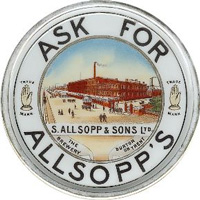A full bottle of Allsopp’s Arctic Ale, brewed and bottled in 1852, sold recently on eBay for a record $503,300. The eBay listing gives a great deal of historical information about the Arctic expedition, as well as the bottle itself:
Until the 1850s Allsopp’s Brewery was most notable for brewing some of the first India Pale Ales for export to the colonies. However, Samuel Allsopp was approached about a different recipe; Sir Edward Belcher was about to led an arctic expedition (1852) to search for the lost explorer Sir John Franklin. The Expedition needed a brew that withstand arctic and sub arctic temperatures, and provide a degree of sustenance and nutritious value. “Captain Belcher reported that Allsopp’s Arctic Ale proved to be “a valuable antiscorbutic”, helping fight off scurvy, the bane of all sea voyages in those days.” He added that the beer was “a great blessing to us, particularly for our sick” and that it refused to freeze until the temperature dropped well below zero.”
What you are looking at is an actual museum quality sealed and intact bottle of Samuel Allsopp’s Arctic Ale brewed for the 1852 Expedition to the Arctic lead by Sir Edward Belcher. This bottle of beer is likely the rarest, oldest, and most documented bottle of beer in existence! Not to mention the unbelievably unique history surrounding it. Accompanying the bottle is an actual limited handwritten history about the bottle itself.
That laminated card you see hanging off the bottle is the handwritten note, which reads:
“This ale was specially brewed and bottled in England, in 1852, for Kane’s Expedition in search of Sir John Franklin. A portion of the lot was cached in the Arctic; and was afterwards taken back to England, where it was bought by Allsopp, from whom Mr. Jus. Fennell obtained a part.
This bottle was given to me by Mr. Fennell May 13, 1919. Should I depart from this (by that time probably) dry world before consuming the contents, let my son and brethren perform my duties and enjoy my rights in that respect, on the eve of my funeral (if they find it in time) – unless such act be then illegal, in which case those of the aforesaid trustees who sufficiently learned in law shall advise ac-????? To the rule of ey fares.
Two bottles of this ale were guests of honor at the banquet given to Shackleton and Peary, in Boston, some years ago. (1907/1908) The skeletons of said guests were preserved as mementos of Sir John Franklin! (Useful suggestion regarding the “cast off shell” of the spirit.)
Signed: Percy G Bolster
A short history of the Allsopp’s Brewery from MidlandsPubs.co.uk page on Staffordshire breweries:

Based in the High Street of Burton-on-Trent, the history of this company can be traced back to the 1740’s. Samuel Allsop acquired the brewery in 1807. A new brewery and offices were constructed in 1859-60 close to the railway station. Throughout the 19th century Allsopp’s brewing business was second only to Bass in size. The new brewery site alone stretched between Station Street and Horninglow Street. They retained the original brewery in High Street, built a large maltings at Shobnall and numerous premises elsewhere. Samuel Allsopp was the first to export Burton Pale Ale to India in 1822. By 1890 their output had reached 460,000 barrels and they had a workforce of 1,750. However, the 20th century was not so favourable for the company and they went into receivership in 1913. Allsopp’s was eventually merged with the neighbouring Ind Coope & Co.Ltd. to form Ind Coope & Allsopp Ltd. The offices of the new brewery were later used as the headquarters of Punch Taverns and the Spirit Group.
There’s another interesting lecture transcribed that goes into great detail about what led to the Allsopp’s Brewery’s demise, entitled “The Fall of the House of Allsopp” by an R.G. Anderson.
What a fascinating little tale. I just hope they don’t open the bottle.
UPDATE: An alert Bulletin reader (thanks Scott) found a similar looking bottle that sold on eBay in June for a mere $305 and wondered if there was something “hokey going on.” A closer look at the two listings reveals that the person who bought the bottle for $305 is the same one who turned around and sold it for a half million. Now that’s a good return on investment.

For curiosity compare these two listings on ebay.
The first is the one you referenced:
http://cgi.ebay.com/Museum-Quality-ALLSOPPs-ARCTIC-ALE-1852-SEALED-FULL_W0QQitemZ260145824374QQihZ016QQcategoryZ1351QQssPageNameZWDVWQQrdZ1QQcmdZViewItem
And the second that looks disturbingly similar but only sold for $304
http://cgi.ebay.com/ws/eBayISAPI.dll?ViewItem&item=270132264843
Looks like one person is a bit of a better salesperson, or there is something hokey going on.
Scott
http://www.newlifeauctions.com/allsopp.html
hey scott. turns out one was a hoax. but it is still worth hella.
So how do you explain the words “trade mark” that appear on the label. The first UK trade mark was issued more than 20 years after this beer was supposedly brewed. Would there have been any legal or practical reason to include “trade mark” on a label in 1852? I’ve also yet to see any authoritative commentary on whether the bottle, the sealing method, the printing process used for the label, etc., are consistent with the early 1850s.